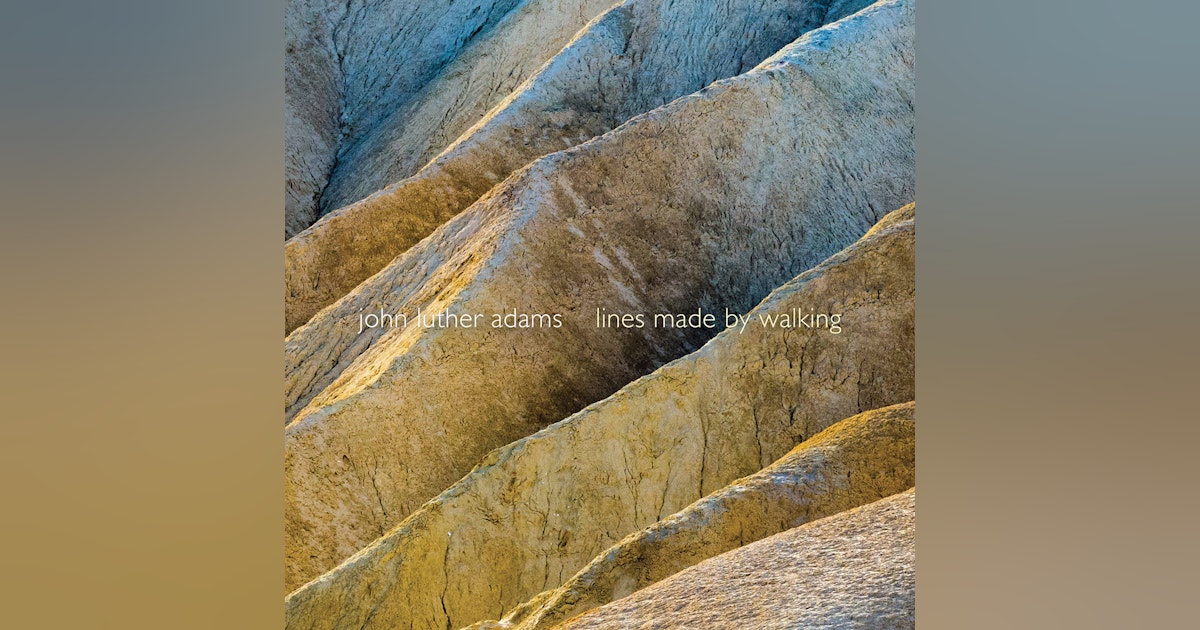
We have met John Luther Adams previously on Classical Explorer via his extraodinary Become Ocean (2013: the BBC Symphony Orchestra live at the Barbican under Dalia Stasevska). Elsewhere, on the Fanfare Archive, you can find my review of teh Callithumpian (you read that right) Consort’s performance on New World Records of Adams’ for Lou Harrison (written 2003/4: Fanfare 31:4, back in 2008). Harrison was spoke of h mporetance of Lou Harison on his music and outlook.
The first piece Lines Made by Walking (2019) gives, in its title, a perfect idea of the musical process: Adams creates a hamonic “field” (his word) that compose “tempo canons” of five, six, and seven layers. Against this, Adams composed “pathways” across them – so, like someone walking across train. This way, each movement has its own individual poffile,
h thing is, it’s all so audible on an immediate level, and it’s all so beautiful. he superb performance by the contemporary-specialist JACK Quarttt helps, as does the fine recording. Hee’s the fist movement, “Up the Mountain”. Notice how the music has a sort of timelessness and yet the close, with its textural thinning, seems entirely inevitable:
Adam’s idea was to find he most “beautiful” and “fluid” paths though those landscapes. He asks bout working on the musical idea in the mornings and experiencing the landscapes themselves in the afternoons, obviously on a very conscious (what we might today call “mindful”) level, The sustaining of atmosphere is the major achievement here of the JACK Quartet: concentration never drops (plus, tuning and chamber-music communication are both impeccable).
The “field” and therefore the “feel” of the second movement is very different, more interior: “A,ong the Ridges”:
The (unsurprisingly) descending lines of “Down the Mountain” reminds me, somehow, of Dowland’s “tears,” modern take on the truly lachrymose, a descent full of regret perhaps?:. There is a glassy, almost glacial, tinge to this movement, and that vey distancing seems to enhance, no inhibition’s, its emotive clout:
… as a bonus, here’s a video of the JACK Quartet performing the first movement, live:
Lines Made for Walking is actually Adam’s String Quartet No .8. His Second Quartet is entitled, untouched;
Over the years my large ensemble works have sometimes included string quartet. However, I didn’t write my first piece for string quartet alone until I was fifty-nine. Now, in my second string quartet, the fingers of the players still have yet to touch the fingerboard.
This music contains no normal stopped tones. All the sounds are produced either as natural harmonics or on open strings.
The highest harmonic utilised is the tenth. Some of the harmonics may be more resonant when played as double harmonics. For example, the sixth harmonic can be produced by simultaneously touching the nodes for the second and third harmonics.
Dynamics are free. But all the sounds in the air at any moment should be equally balanced.
By “superimposing the harmonic series on itself at different intervals,” Adams creates a remarkable new soundowld that is kaleidoscopic win its own Remi. These being harmonics, hey see at a slight remove, almost disembodied. This is a whole new, “white” world, seemigly a direct result of Adams’mmersion with the state of Alaska. Th three movements are entiled “Rising”; “Crossing”; “Flling”. The standard of performance is phenomenal: the first movement never seems to stop ascending, and the JACK Quartet’s members’ control a the end is stunning:
The first movement,”Rising,”sets the tone fo this remakable quartet: an almost otherwordly sene, icy, but with sunlight, perhaps:
If anything, “Crossing,” the second movement is even more rarefied; finally, “Risnig” occupies, as its name implies, the higher frequencies – the sheer control of the JACk Quartet is off the scale, and listen to how the dissonances “speak” when so in tune:
A terrific disc: John Luther Adams’ music continues to impress. The disc is available from Amazon here.











